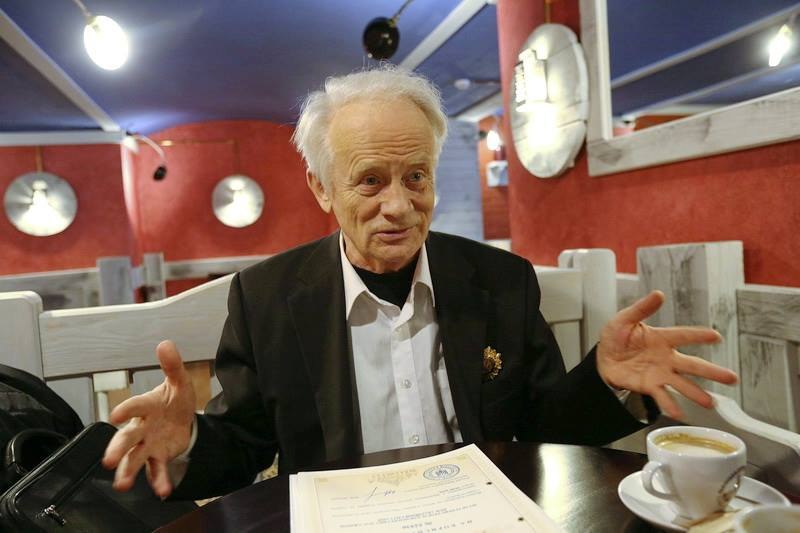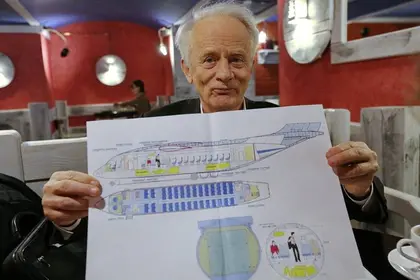Today, aircraft passengers have little chances of survival in the incidents caused by an engine breakage. Even if each one had a parachute and the skills and knowledge to use it, they would also need oxygen and a survival suit to keep them alive in the thin, freezing air when they exit an aircraft at cruising altitudes of 30,000 feet or more.
But what if everyone on board, including the passengers, crew and pilots could be parachuted down safely in a pressurized capsule?
Tatarenko, a 76-year-old engineer and businessman from Kyiv, says his invention can do just that. The system guarantees safe landing for the whole passenger compartment, saving the lives of all, he says.
The suggested device is a capsule contained within the aircraft fuselage that can be ejected in a matter of seconds and evacuate the passengers. First, a rear hatch in the aircraft opens, then a small drag “chute” is fired out of the aircraft, which in turn pulls the entire passenger compartment from the rear of the aircraft.

Next, two sets of large parachutes deploy – three chutes in clusters at each end of the capsule. The capsule descends at a rate of eight-nine meters per second until sensors detect it is nearing landing. Then retro rockets attached to the parachute clusters fire, slowing the capsule’s descent rate to zero just as it touches down. If it lands on water, floatation bags deploy from the capsule’s sides.
In 2013, Tatarenko ordered a video visualization of how his invention works. It was posted on YouTube but didn’t get much reaction until Oct. 31, when the Russian airliner crashed in Egypt, killing all 224 people on board. The video has received 18 million views and 283,000 shares on Facebook.
“But how do the pilots survive?” many people asked in the comments under the video. Tatarenko explains that they move from the cockpit into the passenger compartment before the capsule is ejected, along with the rest of the crew.
The main drawback of the invention is that it can only be used with an aircraft that has a rear hatch, such as some of Ukraine’s Antonov aircrafts. Other aircrafts would require extensive remodeling of their tail sections for the system to work. Also, they would lose at least one column of seats, which would cause a 15 percent rise in the cost of tickets, according to Tatarenko.
However, he doesn’t see the rise in the cost of tickets as a problem.
“So what? One will still buy a ticket for a safe flight, even if it’s 15 percent more expensive,” the inventor says.
Tatarenko came up with the escape capsule idea long ago, but waited until it became practical through the invention of light-weight carbon composite materials that wouldn’t increase aircraft weight too much.
Tatarenko approached his colleagues at the Antonov State Aircraft Company, where he had worked until the Soviet Union collapsed. As part of the team who invented the Antonov An-225 Mriya in 1988, the world’s biggest cargo aircraft, he knew that Ukraine had all the facilities and professional staff needed to bring his idea to life.
But he also knew Antonov lacked cash. Today, Tatarenko is struggling to find investors to build a prototype to test the invention. He needs $1 million to build each capsule and another $40-$60 million to install them inside at least three Ukrainian AN-148 jet airliners designed by Antonov.
Tatarenko turned to the Transport Ministry, but was rejected because they didn’t have the money for it. Tatarenko says that investors from Canada, Brazil, the United States and Russia have called him, proposing to buy the rights to his patent for the system, he says. He is resistant to do that. He would like the Ukrainian aircraft builders to implement his invention.
But so far, no Ukrainian investors were interested.
Kyiv Post staff writer Yuliana Romanyshyn can be reached at [email protected].
You can also highlight the text and press Ctrl + Enter







Comments (0)